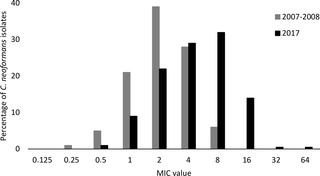当前位置:
X-MOL 学术
›
PLOS Negl. Trop. Dis.
›
论文详情
Our official English website, www.x-mol.net, welcomes your
feedback! (Note: you will need to create a separate account there.)
Decreasing fluconazole susceptibility of clinical South African Cryptococcus neoformans isolates over a decade.
PLOS Neglected Tropical Diseases ( IF 3.4 ) Pub Date : 2020-03-31 , DOI: 10.1371/journal.pntd.0008137 Serisha D Naicker 1, 2 , Ruth S Mpembe 1 , Tsidiso G Maphanga 1, 3 , Thokozile G Zulu 1 , Daniel Desanto 1, 2 , Jeannette Wadula 4 , Nomonde Mvelase 5 , Caroline Maluleka 6 , Kessendri Reddy 7 , Halima Dawood 8 , Motlatji Maloba 9 , Nelesh P Govender 1, 2, 10 ,
PLOS Neglected Tropical Diseases ( IF 3.4 ) Pub Date : 2020-03-31 , DOI: 10.1371/journal.pntd.0008137 Serisha D Naicker 1, 2 , Ruth S Mpembe 1 , Tsidiso G Maphanga 1, 3 , Thokozile G Zulu 1 , Daniel Desanto 1, 2 , Jeannette Wadula 4 , Nomonde Mvelase 5 , Caroline Maluleka 6 , Kessendri Reddy 7 , Halima Dawood 8 , Motlatji Maloba 9 , Nelesh P Govender 1, 2, 10 ,
Affiliation

|
BACKGROUND
Fluconazole is used in combination with amphotericin B for induction treatment of cryptococcal meningitis and as monotherapy for consolidation and maintenance treatment. More than 90% of isolates from first episodes of cryptococcal disease had a fluconazole minimum inhibitory concentration (MIC) ≤4 μg/ml in a Gauteng population-based surveillance study of Cryptococcus neoformans in 2007-2008. We assessed whether fluconazole resistance had emerged in clinical cryptococcal isolates over a decade.
METHODOLOGY AND PRINCIPAL FINDINGS
We prospectively collected C. neoformans isolates from 1 January through 31 March 2017 from persons with a first episode of culture-confirmed cryptococcal disease at 37 South African hospitals. Isolates were phenotypically confirmed to C. neoformans species-complex level. We determined fluconazole MICs (range: 0.125 μg/ml to 64 μg/ml) of 229 C. neoformans isolates using custom-made broth microdilution panels prepared, inoculated and read according to Clinical and Laboratory Standards Institute M27-A3 and M60 recommendations. These MIC values were compared to MICs of 249 isolates from earlier surveillance (2007-2008). Clinical data were collected from patients during both surveillance periods. There were more males (61% vs 39%) and more participants on combination induction antifungal treatment (92% vs 32%) in 2017 compared to 2007-2008. The fluconazole MIC50, MIC90 and geometric mean MIC was 4 μg/ml, 8 μg/ml and 4.11 μg/ml in 2017 (n = 229) compared to 1 μg/ml, 2 μg/ml and 2.08 μg/ml in 2007-2008 (n = 249) respectively. Voriconazole, itraconazole and posaconazole Etests were performed on 16 of 229 (7%) C. neoformans isolates with a fluconazole MIC value of ≥16 μg/ml; only one had MIC values of >32 μg/ml for these three antifungal agents.
CONCLUSIONS AND SIGNIFICANCE
Fluconazole MIC50 and MIC90 values were two-fold higher in 2017 compared to 2007-2008. Although there are no breakpoints, higher fluconazole doses may be required to maintain efficacy of standard treatment regimens for cryptococcal meningitis.
中文翻译:

在过去的十年中,南非临床新型隐球菌对氟康唑的敏感性下降。
背景技术氟康唑与两性霉素B联合用于诱导治疗隐球菌性脑膜炎和作为巩固和维持治疗的单一疗法。在2007-2008年基于豪登省人群的新型隐球菌监测研究中,隐球菌疾病首发的分离株中有90%以上的氟康唑最低抑菌浓度(MIC)≤4μg/ ml。我们评估了十多年来临床隐球菌分离株中是否出现了氟康唑耐药性。方法学和主要发现我们从2017年1月1日至3月31日前瞻性收集了南非37所医院中首例经文化证实的隐球菌病的人的新产梭状芽胞杆菌分离株。从表型上将分离物确认为新孢梭菌物种-复杂水平。我们确定了氟康唑的MIC(范围:使用定制的肉汤微量稀释板根据临床和实验室标准协会M27-A3和M60的建议进行制备,接种和阅读,从而将229株新形成的C.新形成菌(0.125μg/ ml至64μg/ ml)分离出来。将这些MIC值与来自早期监测(2007-2008)的249个分离株的MIC进行了比较。在两个监测期间均从患者收集临床数据。与2007-2008年相比,2017年男性接受联合抗真菌治疗的人数更多(分别为61%和39%)和更多参与者(92%和32%)。2017年氟康唑的MIC50,MIC90和几何平均MIC为4μg/ ml,8μg/ ml和4.11μg/ ml(n = 229),而2007年为1μg/ ml,2μg/ ml和2.08μg/ ml 2008(n = 249)。伏立康唑,伊曲康唑和泊沙康唑Etests在229(7%)C中的16个进行。氟康唑MIC值≥16μg/ ml的新分离株;这三种抗真菌剂的MIC值均仅> 32μg/ ml。结论和意义2017年氟康唑的MIC50和MIC90值是2007-2008年的两倍。尽管没有断点,但可能需要更高的氟康唑剂量才能维持隐球菌性脑膜炎标准治疗方案的有效性。
更新日期:2020-03-31
中文翻译:

在过去的十年中,南非临床新型隐球菌对氟康唑的敏感性下降。
背景技术氟康唑与两性霉素B联合用于诱导治疗隐球菌性脑膜炎和作为巩固和维持治疗的单一疗法。在2007-2008年基于豪登省人群的新型隐球菌监测研究中,隐球菌疾病首发的分离株中有90%以上的氟康唑最低抑菌浓度(MIC)≤4μg/ ml。我们评估了十多年来临床隐球菌分离株中是否出现了氟康唑耐药性。方法学和主要发现我们从2017年1月1日至3月31日前瞻性收集了南非37所医院中首例经文化证实的隐球菌病的人的新产梭状芽胞杆菌分离株。从表型上将分离物确认为新孢梭菌物种-复杂水平。我们确定了氟康唑的MIC(范围:使用定制的肉汤微量稀释板根据临床和实验室标准协会M27-A3和M60的建议进行制备,接种和阅读,从而将229株新形成的C.新形成菌(0.125μg/ ml至64μg/ ml)分离出来。将这些MIC值与来自早期监测(2007-2008)的249个分离株的MIC进行了比较。在两个监测期间均从患者收集临床数据。与2007-2008年相比,2017年男性接受联合抗真菌治疗的人数更多(分别为61%和39%)和更多参与者(92%和32%)。2017年氟康唑的MIC50,MIC90和几何平均MIC为4μg/ ml,8μg/ ml和4.11μg/ ml(n = 229),而2007年为1μg/ ml,2μg/ ml和2.08μg/ ml 2008(n = 249)。伏立康唑,伊曲康唑和泊沙康唑Etests在229(7%)C中的16个进行。氟康唑MIC值≥16μg/ ml的新分离株;这三种抗真菌剂的MIC值均仅> 32μg/ ml。结论和意义2017年氟康唑的MIC50和MIC90值是2007-2008年的两倍。尽管没有断点,但可能需要更高的氟康唑剂量才能维持隐球菌性脑膜炎标准治疗方案的有效性。











































 京公网安备 11010802027423号
京公网安备 11010802027423号